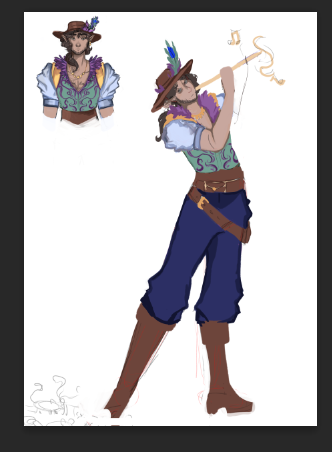
Story project
or "how i made an npc''
In this short project, it was my goal to use an old forgotten fairy tale to design a new character which could be used in D&D.
The story I chose was the Pied Piper of Hamelin because I think the character could be really iconic and funny.
I started to do research about the character in the story (which I will copy below).
In 1284, while the town of Hamelin was suffering from a rat infestation, a piper dressed in multicolored ("pied") clothing appeared, claiming to be a rat-catcher. He promised the mayor a solution to their problem with the rats. The mayor, in turn, promised to pay him for the removal of the rats (the promised sum was 1,000 guilders). The piper accepted and played his pipe to lure the rats into the Weser River, where all the rats drowned.[4]
Despite the piper's success, the mayor reneged on his promise and refused to pay him the full sum (reputedly reduced to a sum of 50 guilders) even going so far as to blame the piper for bringing the rats himself in an extortion attempt. Enraged, the piper stormed out of the town, vowing to return later to take revenge. On Saint John and Paul's day, while the adults were in church, the piper returned, dressed in green like a hunter and playing his pipe. In so doing, he attracted the town's children. One hundred and thirty children followed him out of town and into a cave, after which they were never seen again. Depending on the version, at most three children remained behind: one was lame and could not follow quickly enough, the second was deaf and therefore could not hear the music, and the last was blind and therefore unable to see where he was going. These three informed the villagers of what had happened when they came out from church.[4]
Other versions relate that the Pied Piper led the children to the top of Koppelberg Hill, where he took them to a beautiful land,[5] or a place called Koppenberg Mountain,[6] or Transylvania. In yet other versions, he made them walk into the Weser as he did with the rats, and they all drowned. Or, the Piper returned the children after extorting payment, or the children were only returned after the villagers paid several times the original payment in gold.
The Hamelin street named Bungelosenstrasse ("street without drums") is believed to be the last place that the children were seen. Ever since, music or dancing is not allowed on this street.
The character seems to be petty. My version obviously does not drown the children but is a very charismatic con artist.

Pied apparently means brightly colored, and green is also mentioned as he was dressed like a hunter, which makes it sound like he's hunting the children. Anyway, I decided to use at least some green in his design.

I really liked the peacock feather, even if it doesn't make sense for him to have one. Peacocks seem to have only come to Europe around the 17th century, while the story takes place in 1284 in Germany, but don't quote me on that.
To me, a peacock feather is a symbol of pride, which made sense for his character because the character in the story comes across as proud to me.
I chose the top right design because to me, it popped the most.
made a more detailed version

I decided to make him a half-elf, a Druid/Bard multiclass. He uses wildshape to transform into a rat, allowing him to to get away with his crimes.
He looks a little angry in this drawing. But you would be angry too if you were on a wanted poster.

gave him a name as wel.
Made his last name Hamelin as a refrence to his story origin.
Here is my process of working on a full-body drawing of him.









I like his face here more than in the end product, but he looks a little angry, and I want him to come across as charismatic.


Finished product.
Please don't look at the hands. I know they're wrong, I just don't know how to fix them without starting over.

I know the rats look weird, but I think they're funny.



